Human embryonic development
| Part of a series on |
| Human growth and development |
|---|
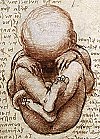 |
| Stages |
| Biological milestones |
| Development and psychology |
Human embryonic development or human embryogenesis is the development and formation of the human
Human embryology is the study of this development during the first eight weeks after fertilization. The normal period of gestation (pregnancy) is about nine months or 40 weeks.
The germinal stage refers to the time from fertilization through the development of the early embryo until
In comparison to the embryo, the fetus has more recognizable external features and a more complete set of developing organs. The entire process of embryogenesis involves coordinated spatial and temporal changes in gene expression, cell growth and cellular differentiation. A nearly identical process occurs in other species, especially among chordates.
Germinal stage
Fertilization
Fertilization takes place when the
Successful fertilization is enabled by three processes, which also act as controls to ensure species-specificity. The first is that of
Cleavage

The beginning of the cleavage process is marked when the zygote divides through mitosis into two cells. This mitosis continues and the first two cells divide into four cells, then into eight cells and so on. Each division takes from 12 to 24 hours. The zygote is large compared to any other cell and undergoes cleavage without any overall increase in size. This means that with each successive subdivision, the ratio of nuclear to cytoplasmic material increases.[5]
Initially, the dividing cells, called
When the cells number around sixteen, the solid sphere of cells within the zona pellucida is referred to as a
Blastulation

Cleavage itself is the first stage in
The trophoblasts secrete fluid into the blastocoel. The resulting increase in size of the blastocyst causes it to
The inner cell mass will give rise to the
The trophoblast will also develop two sub-layers: the cytotrophoblast, which is in front of the syncytiotrophoblast, which in turn lies within the endometrium.[10] Next, another layer called the exocoelomic membrane or Heuser's membrane will appear and surround the cytotrophoblast, as well as the primitive yolk sac.[11] The syncytiotrophoblast will grow and will enter a phase called lacunar stage, in which some vacuoles will appear and be filled by blood in the following days.[10][11] The development of the yolk sac starts with the hypoblastic flat cells that form the exocoelomic membrane, which will coat the inner part of the cytotrophoblast to form the primitive yolk sac. An erosion of the endothelial lining of the maternal capillaries by the syncytiotrophoblastic cells results in the formation of the maternal sinusoids from where the blood will begin to penetrate and flow into and through the trophoblastic lacunae to give rise to the uteroplacental circulation.[12][13] Subsequently, new cells derived from yolk sac will be established between trophoblast and exocoelomic membrane and will give rise to extra-embryonic mesoderm, which will form the chorionic cavity.[11]
At the end of the second week of development, some cells of the trophoblast penetrate and form rounded columns into the syncytiotrophoblast. These columns are known as primary villi. At the same time, other migrating cells form into the exocoelomic cavity a new cavity named the secondary or definitive yolk sac, smaller than the primitive yolk sac.[11][12]
Implantation
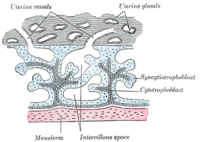
After
layer without cell boundaries.The syncytiotrophoblast implants the blastocyst in the decidual
As the syncytiotrophoblast starts to penetrate the uterine wall, the inner cell mass (embryoblast) also develops. The inner cell mass is the source of embryonic
Embryonic disc
The embryoblast forms an
Gastrulation



The
The neural plate will form opposite the primitive streak from ectodermal tissue which thickens and flattens into the neural plate. The epiblast in that region moves down into the streak at the location of the primitive pit where the process called
The three germ layers are the
Following ingression, a
Neurulation

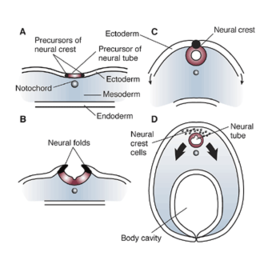
Following gastrulation, the ectoderm gives rise to epithelial and
The embryonic disc begins flat and round, but eventually elongates to have a wider cephalic part and narrow-shaped caudal end.
Development of organs and organ systems

Blood
In the centre of a blood island, hemangioblasts form the haematopoietic stem cells that are the precursor to all types of blood cell. In the periphery of a blood island the hemangioblasts differentiate into angioblasts, the precursors to the blood vessels.[20]
Heart and circulatory system
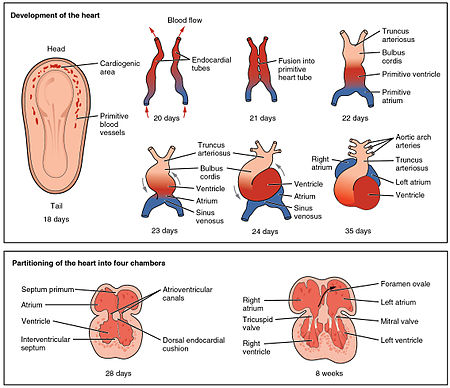
The heart is the first functional organ to develop and starts to beat and pump blood at around 22 days.
Also at the same time that the endocardial tubes are forming, vasculogenesis (the development of the circulatory system) has begun. This starts on day 18 with cells in the splanchnopleuric mesoderm differentiating into angioblasts that develop into flattened endothelial cells. These join to form small vesicles called angiocysts which join up to form long vessels called angioblastic cords. These cords develop into a pervasive network of plexuses in the formation of the vascular network. This network grows by the additional budding and sprouting of new vessels in the process of angiogenesis.[22] Following vasculogenesis and the development of an early vasculature, a stage of vascular remodelling takes place.
The tubular heart quickly forms five distinct regions. From head to tail, these are the infundibulum, bulbus cordis, primitive ventricle, primitive atrium, and the sinus venosus. Initially, all venous blood flows into the sinus venosus, and is propelled from tail to head to the truncus arteriosus. This will divide to form the aorta and pulmonary artery; the bulbus cordis will develop into the right (primitive) ventricle; the primitive ventricle will form the left ventricle; the primitive atrium will become the front parts of the left and right atria and their appendages, and the sinus venosus will develop into the posterior part of the right atrium, the sinoatrial node and the coronary sinus.[21]
Cardiac looping begins to shape the heart as one of the processes of morphogenesis, and this completes by the end of the fourth week. Programmed cell death (apoptosis) at the joining surfaces enables fusion to take place.[22] In the middle of the fourth week, the sinus venosus receives blood from the three major veins: the
During the first two months of development, the
A second septum (the
Digestive system
The digestive system starts to develop from the third week and by the twelfth week, the organs have correctly positioned themselves.
Respiratory system
The respiratory system develops from the lung bud, which appears in the ventral wall of the foregut about four weeks into development. The lung bud forms the trachea and two lateral growths known as the bronchial buds, which enlarge at the beginning of the fifth week to form the left and right main bronchi. These bronchi in turn form secondary (lobar) bronchi; three on the right and two on the left (reflecting the number of lung lobes). Tertiary bronchi form from secondary bronchi.
While the internal lining of the larynx originates from the lung bud, its cartilages and muscles originate from the fourth and sixth pharyngeal arches.[23]
Urinary system
Kidneys
Three different kidney systems form in the developing embryo: the pronephros, the mesonephros and the metanephros. Only the metanephros develops into the permanent kidney. All three are derived from the intermediate mesoderm.
Pronephros
The pronephros derives from the intermediate mesoderm in the cervical region. It is not functional and degenerates before the end of the fourth week.
Mesonephros
The mesonephros derives from intermediate mesoderm in the upper thoracic to upper lumbar segments. Excretory tubules are formed and enter the mesonephric duct, which ends in the cloaca. The mesonephric duct atrophies in females, but participate in development of the reproductive system in males.
Metanephros
The metanephros appears in the fifth week of development. An outgrowth of the mesonephric duct, the
Bladder and urethra
Between the fourth and seventh weeks of development, the
Reproductive system
Integumentary system
The superficial layer of the skin, the epidermis, is derived from the ectoderm. The deeper layer, the dermis, is derived from mesenchyme.
The formation of the epidermis begins in the second month of development and it acquires its definitive arrangement at the end of the fourth month. The ectoderm divides to form a flat layer of cells on the surface known as the periderm. Further division forms the individual layers of the epidermis.
The mesenchyme that will form the dermis is derived from three sources:
- The mesenchyme that forms the dermis in the limbs and body wall derives from the lateral plate mesoderm
- The mesenchyme that forms the dermis in the back derives from paraxial mesoderm
- The mesenchyme that forms the dermis in the face and neck derives from neural crest cells[23]
Nervous system
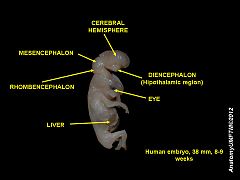
Late in the fourth week, the superior part of the neural tube bends ventrally as the
Cranial neural crest cells migrate to the pharyngeal arches as neural stem cells, where they develop in the process of neurogenesis into neurons.
The optical vesicle (which eventually becomes the optic nerve, retina and iris) forms at the basal plate of the prosencephalon. The alar plate of the prosencephalon expands to form the cerebral hemispheres (the telencephalon) whilst its basal plate becomes the diencephalon. Finally, the optic vesicle grows to form an optic outgrowth.
Development of physical features
Face and neck
This section needs expansion. You can help by adding to it. (November 2017) |
From the third to the eighth week the
Ears
The inner ear, middle ear and outer ear have distinct embryological origins.
Inner ear
At about 22 days into development, the ectoderm on each side of the rhombencephalon thickens to form otic placodes. These placodes invaginate to form otic pits, and then otic vesicles. The otic vesicles then form ventral and dorsal components.
The ventral component forms the saccule and the cochlear duct. In the sixth week of development the cochlear duct emerges and penetrates the surrounding mesenchyme, travelling in a spiral shape until it forms 2.5 turns by the end of the eighth week. The saccule is the remaining part of the ventral component. It remains connected to the cochlear duct via the narrow ductus reuniens.
The dorsal component forms the utricle and semicircular canals.
Middle ear
The first pharyngeal pouch lengthens and expands to form the tubotympanic recess. This recess differentiates to form most of the tympanic cavity of the middle ear, and all of the Eustachian or auditory tube. The narrow auditory tube connects the tympanic cavity to the pharynx.[25]
The bones of the middle ear, the ossicles, derive from the cartilages of the pharyngeal arches. The malleus and incus derive from the cartilage of the first pharyngeal arch, whereas the stapes derives from the cartilage of the second pharyngeal arch.
Outer ear
The external auditory meatus develops from the dorsal portion of the first pharyngeal cleft. Six auricular hillocks, which are mesenchymal proliferations at the dorsal aspects of the first and second pharyngeal arches, form the auricle of the ear.[23]
Eyes
The eyes begin to develop from the third week to the tenth week.

Limbs
This section needs expansion. You can help by adding to it. (November 2017) |
At the end of the fourth week limb development begins. Limb buds appear on the ventrolateral aspect of the body. They consist of an outer layer of ectoderm and an inner part consisting of mesenchyme which is derived from the parietal layer of lateral plate mesoderm. Ectodermal cells at the distal end of the buds form the apical ectodermal ridge, which creates an area of rapidly proliferating mesenchymal cells known as the progress zone. Cartilage (some of which ultimately becomes bone) and muscle develop from the mesenchyme.[23]
Clinical significance
Toxic exposures in the embryonic period can be the cause of major
Each cell of the preimplantation embryo has the potential to form all of the different cell types in the developing embryo. This cell potency means that some cells can be removed from the preimplantation embryo and the remaining cells will compensate for their absence. This has allowed the development of a technique known as preimplantation genetic diagnosis, whereby a small number of cells from the preimplantation embryo created by IVF, can be removed by biopsy and subjected to genetic diagnosis. This allows embryos that are not affected by defined genetic diseases to be selected and then transferred to the mother's uterus.
Sacrococcygeal teratomas, tumours formed from different types of tissue, that can form, are thought to be related to primitive streak remnants, which ordinarily disappear.[10][11][13]
Vertically transmitted infections can be passed from the mother to the unborn child at any stage of its development.
See also
Additional images
-
Representing different stages of embryogenesis
-
Early stage of the gastrulation process
-
Phase of the gastrulation process
-
Top of the form of the embryo
-
Establishment of embryo medium
-
Spinal cord at five weeks
-
Head and neck at 32 days
References
- ^ "germinal stage". Mosby's Medical Dictionary, 8th edition. Elsevier. Retrieved 6 October 2013.
- ISBN 978-0128152218.
- ^ ISBN 978-8131236208.
- ISBN 978-0702068515.
- ^ ISBN 978-0-521-78337-8.
- ISBN 978-0702068515.
- PMID 24795173.
- ISBN 978-981-283-513-0.
- ^ "28.2 Embryonic Development – Anatomy and Physiology". opentextbc.ca.
- ^ ISBN 0-8151-1458-3.
- ^ ISBN 978-84-15419-83-9.
- ^ ISBN 0-7216-9412-8.
- ^ ISBN 0-443-06583-7.
- ISBN 0-13-250882-6.
- ^ ISBN 84-370-1006-3.
- ISBN 978-3-13-142081-7.
- ^ "Pregnancy week by week". Retrieved 28 July 2010.
- S2CID 16291509.
- ISBN 0-443-06583-7.
- ISBN 9780781790697.
- ^ ISBN 978-1938168130.
- ^ ISBN 0-443-06583-7.
- ^ OCLC 732776409.
- PMID 37507490.
- ISBN 9781455706846.







